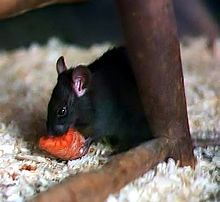SSMakambo
 Makamboat anchor
| |
| History | |
|---|---|
| Name | SSMakambo |
| Owner | Burns Philp & Co. Ltd |
| Builder | Clyde Shipbuilding Company,Port Glasgow |
| Yard number | 273 |
| Launched | 16 March 1907 |
| In service | 1907 |
| Out of service | 12 June 1944 |
| Fate | Sunk byHMSStoicoffPhuket12 June 1944 |
| General characteristics | |
| Tonnage | 1159grt |
| Length | 210.3 feet |
| Beam | 31.4 feet |
| Installed power | Triple expansion engine |
| Propulsion | Screw |
SSMakambowas asteamshipfirst owned byBurns Philp & Co. Ltd.She was built inPort Glasgowin Scotland and named after an island in theSolomon Islands.She carried both passengers and cargo and was principally used on routes between easternAustraliaand islands inMelanesiaand theTasman Sea.In November 1908Jack and Charmian Londontravelled from Guadalcanal to Sydney on theMakamboafter abandoning their ill-fated circumnavigation of the world on theSnark,a 45' sailing yawl.
Between 1910 and 1931, she travelled a regular route betweenSydneyandPort Vilain theNew Hebrides,with stops atLord Howe IslandandNorfolk Island.[1]On 1 August 1921, theMakambo's captain sent, by radio, the first report thatflotsamfrom the missing cargo steamerSSCanastotahad washed ashore at Lord Howe Island.[2]
She was acquired in 1939 by Okada Gumi KK ofOsaka,Japan,and renamedKainan Maru.She was torpedoed and sunk on 12 June 1944 by theBritishsubmarineHMSStoicoffPhuket,Thailand.[3]
Grounding at Lord Howe Island
[edit]On 15 June 1918Makamboran aground near Neds Beach, at the northern end ofLord Howe Island.There was only one immediate casualty; a passenger, Miss Readon, was drowned when a boat capsized during the evacuation of passengers and crew from the vessel.[4]The ship was only temporarily out of service until repairs could be made; however,Makambowas aground for nine days before she was refloated. The incident had allowedblack ratsto leave the ship and go ashore on the island, where they thrived. This introduction gave rise to anenvironmental disaster,with the rats causing the extinction of several of the island's endemic birds and other fauna in the next few years through predation, as well as causing hardship to the islanders by raiding their crops and only export commodity, the seeds of thekentia palm.[5]

Problems with the rats led to an attempted ecological solution through the deliberate introduction ofTasmanian masked owlsbetween 1922 and 1930 to the island, an action which compounded the disaster by adding another predator to the ecosystem.[5][6]Birds which became extinct soon after the arrival of rats include theLord Howe Island thrush,Lord Howe gerygone,Lord Howe starling,Lord Howe fantailandrobust white-eye.TheLord Howe boobookmay have been eliminated by the introduced masked owls. Variousseabirdswere wiped out as breeding species on the main island, though they persist elsewhere.[6][7]The giantLord Howe Island stick insectalso became extinct on the main island in 1920, and was believed to be completely gone until a tiny population of survivors was discovered onBall's Pyramidin 2001 (there are plans to reintroduce them).[8]Rats are also implicated in the population declines and extinctions of Lord Howe's endemiclizards,land snailsandbeetles.[9]
Makambo Rock, north of Malabar Hill on Lord Howe Island, was named after the grounding of theMakambonear there.[4]
References
[edit]- ^Breckon, Richard. (June 2006). Mail links to the "last paradise" – a postal history of Lord Howe Island. Gibbons Stamp Monthly.[1][permanent dead link]
- ^"THE MISSING CANASTOTA".Daily Commercial News and Shipping List.Sydney. 2 August 1921. p. 4.Retrieved13 February2018.
- ^Shipping Times: SS Makambo
- ^ab"Maritime Heritage Online – New South Wales".Archived fromthe originalon 21 June 2009.Retrieved8 April2009.
- ^abHindwood, K.A. (1940). The Birds of Lord Howe Island.Emu40:1-86.
- ^abGarnett, Stephen T.; & Crowley, Gabriel M. (2000).The Action Plan for Australian Birds 2000.Environment Australia: Canberra.ISBN0-642-54683-5"Archived copy"(PDF).Archived fromthe original(PDF)on 8 January 2009.Retrieved8 April2009.
{{cite web}}:CS1 maint: archived copy as title (link)p.633. - ^Naturalis: Turdidae (Thrushes) – Lord Howe ThrushArchived17 July 2011 at theWayback Machine
- ^Six-Legged Giant Finds Secret Hideaway, Hides For 80 Years
- ^Australian Museum - Science Bytes (17 March 2008): Beetle extinctions on Lord Howe Island.
- Biological invasions
- Merchant ships of Australia
- Ships sunk by British submarines
- Lord Howe Island
- Ships built on the River Clyde
- 1907 ships
- World War II shipwrecks in the Indian Ocean
- 1918 in the environment
- World War II merchant ships of Japan
- Maritime incidents in 1918
- Maritime incidents in June 1944
- Environmental disasters in Australia
